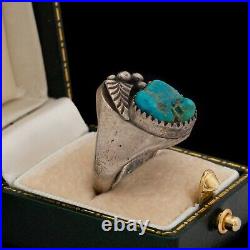
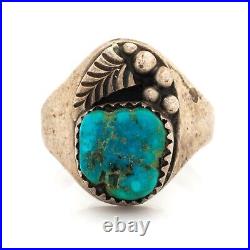
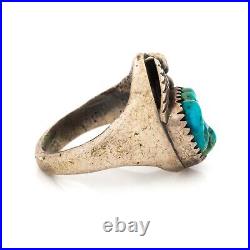
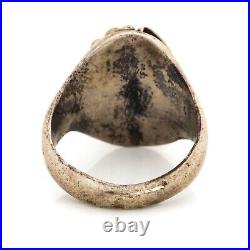

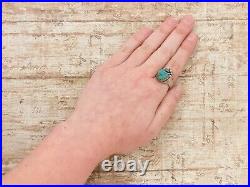

We have similar Turquoise and Native American items, which would pair nicely with this piece, for sale this week. Listing description by: Angela A. Markings : Unmarked, tested, and guaranteed. Main stone : Fox turquoise. Length: 10.58 mm. Width : 10.09 mm. Color: opaque bright blue hue with a tan matrix. Accent stone measurements/color. Stone treatment : The stone(s) appear to be untreated, but we are not certified gemologists. Stone(s) have been tested and guaranteed using a professional Presidium Duo refractive, heat, and hardness tester. Stone cuts : Carved and polished cabochon. Handmade in the 1950s by a talented Diné silversmith. 900 sterling silver, also known as coin silver, a popular purity of silver during this time period. Beautiful Fox turquoise cabochon rests in a saw tooth bezel setting. A curling leaf and berry motif accents one end of the stone. Smooth, polished band for comfortable wear. Damage : Age appropriate wear. What appears to be a mark from a past sizing is visible at the bottom of the band; this does not affect wear. There is minor wear to the inside of the band. Tarnish on the sterling silver gives the piece an antique quality we believe is rather lovely; tarnish can be removed with a buffing. The price has been reduced to reflect this. This listing is for the item only. This beautiful piece was made by a very talented Native American silversmith. It features handcrafted silversmith work throughout. Antique Native American jewelry is very rare to find. This is due to these pieces being made for reservation and personal use before the tourist trade became popular. Very few pieces were made and even less survived to today. The Navajo Nation sits on 27,000 square miles within the states of Arizona, New Mexico, and Utah. The Navajo have a rich history and culture and have become known for creating some of the finest sterling silver and turquoise jewelry, incorporating their own traditional motifs with silversmithing. The squash blossom necklace is perhaps one the most famous Navajo styles produced, along with turquoise inlay rings. Turquoise is an important stone in Navajo culture; symbolizing happiness, good fortune, and good health. The first Navajo silversmith, Atsidi Sani, was taught around 1865 by a Mexican silversmith. Atsidi Sani, in turn, taught his four sons, who then started teaching other Navajo artisans. In the beginning, Navajo artisans created sterling silver jewelry for themselves and others in the Navajo Nation. The concept of Pawn, Old Pawn, and Dead Pawn Native American Jewelry came to be in the 1800s. When a loan wasn’t repaid, the item became known as either “Old Pawn” or Dead Pawn. Turquoise is found all over the world and has been a popular semi-precious stone used in jewelry and art for thousands of years by many different cultures; from prehistoric times to the present. Turquoise comes in many beautiful color variations; from the popular bright solid sky-blue hues to dark blue hues with dark spiderwebbing throughout, as well as aqua, teal, and many green varieties, and even some rare white with dark spiderwebbing. Fox Turquoise Mine is one of Nevada’s most productive and famous turquoise mines and produces a huge amount of high quality light to medium blue, green, and aqua blue stone with a distinctive water web matrix; a matrix consisting of darker hues of green or blue spiderwebbing. Navajo silversmiths, working from 1870 to 1900, learned about stamping from Mexican leather workers, and adopted this to their metal working. Artisans made their own stamps that were passed down to each generation. Stampings are usually hand hammered using handcrafted or die stamps and include traditional Native American symbols, such as sunbursts, to ornate landscapes. This technique has been passed on and utilized by other Native American tribes and continues to be a popular method of jewelry making.

